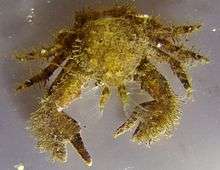Porcelain crab
| Porcelain crabs Temporal range: Tithonian–Recent | |
|---|---|
 | |
| A Porcelain crab in Mauritius | |
| Scientific classification | |
| Kingdom: | Animalia |
| Phylum: | Arthropoda |
| Subphylum: | Crustacea |
| Class: | Malacostraca |
| Order: | Decapoda |
| Infraorder: | Anomura |
| Superfamily: | Galatheoidea |
| Family: | Porcellanidae Haworth, 1825 |
| Genera | |
|
See text | |
Porcelain crabs are decapod crustaceans in the widespread family Porcellanidae, which superficially resemble true crabs. They have flattened bodies as an adaptation for living in rock crevices. They are delicate, readily losing limbs when attacked, and use their large claws for maintaining territories.
Description
Porcelain crabs are small, usually with body widths of less than 15 mm (0.59 in).[1] They share the general body plan of a squat lobster, but their bodies are more compact and flattened, an adaptation for living and hiding under rocks.[2] Porcelain crabs are quite fragile animals, and will often shed their limbs to escape predators,[3] hence their name. The lost appendage can grow back over several moults. Porcelain crabs have large chelae (claws), which are used for territorial struggles, but not for catching food.[1] The fifth pair of pereiopods is reduced and used for cleaning.[4]
Evolution
Porcelain crabs are an example of carcinisation, whereby a noncrab-like animal (in this case a relative of a squat lobster) evolves into an animal that resembles a true crab.[5][6] Porcelain crabs can be distinguished from true crabs by the apparent number of walking legs (three instead of four pairs, the fourth pair is reduced and held against the carapace), and the long antennae originating on the front outside of the eyestalks.[3] The abdomen of the porcelain crab is long and folded underneath it, free to move.[3]
Biogeography and ecology
Porcelain crabs live in all the world's oceans, except the Arctic Ocean and the Antarctic.[7] They are common under rocks, and can often be found and observed on rocky beaches and shorelines, startled creatures scurrying away when a stone is lifted. They feed by combing plankton and other organic particles from the water using long setae (feathery hair- or bristle-like structures) on the mouthparts.[4]
Some of the common species of porcelain crabs in the Caribbean Sea are Petrolisthes quadratus, found in large numbers under rocks in the intertidal, and the red-and-white polka-dotted Porcellana sayana, which lives commensally within the shells inhabited by large hermit crabs. In Hong Kong, Petrolisthes japonicus is common.[2]
Diversity
As of 2010, some 277 extant species porcelain crab had been described,[8] divided among these 30 genera:[8][9]
- Aliaporcellana Nakasone & Miyake, 1969
- Allopetrolisthes Haig, 1960
- Ancylocheles Haig, 1978
- Capilliporcellana Haig, 1978
- Clastotoechus Haig, 1960
- Enosteoides Johnson, 1970
- Euceramus Stimpson, 1860
- Eulenaios Ng & Nakasone, 1993
- Heteropolyonyx Osawa, 2001
- Heteroporcellana Haig, 1978
- Liopetrolisthes Haig, 1960
- Lissoporcellana Haig, 1978
- Madarateuchus Harvey, 1999
- Megalobrachium Stimpson, 1858
- Minyocerus Stimpson, 1858
- Neopetrolisthes Miyake, 1937
- Neopisosoma Haig, 1960
- Novorostrum Osawa, 1998
- Orthochela Glassell, 1936
- Pachycheles Stimpson, 1858
- Parapetrolisthes Haig, 1962
- Petrocheles Miers, 1876
- Petrolisthes Stimpson, 1858
- Pisidia Leach, 1820
- Polyonyx Stimpson, 1858
- Porcellana Lamarck, 1801
- Porcellanella White, 1852
- Pseudoporcellanella Sankarankutty, 1962
- Raphidopus Stimpson, 1858
- Ulloaia Glassell, 1938
The fossil record of porcelain crabs includes species of Pachycheles, Pisidia, Polyonyx, Porcellana, and a further 6 genera known only from fossils:[10]
- Annieporcellana Fraaije et al., 2008
- Beripetrolisthes De Angeli & Garassino, 2002
- Eopetrolisthes De Angeli & Garassino, 2002
- Jurellana Schweitzer & Feldmann, 2010
- Lobipetrolisthes De Angeli & Garassino, 2002
- Longoporcellana Müller & Collins, 1991
The earliest porcelain crab fossil is Jurellana from the Tithonian of central Europe.[10]
References
- 1 2 Mark W. Denny & Steven Dean Gaines (2007). "Crabs". Encyclopedia of Tidepools and Rocky Shores. Issue 1 of Encyclopedias of the Natural World. University of California Press. pp. 164–176. ISBN 978-0-520-25118-2.
- 1 2 Brian Morton & John Edward Morton (1993). "Boulder shores". The Sea Shore Ecology of Hong Kong. Hong Kong University Press. pp. 86–125. ISBN 978-962-209-027-9.
- 1 2 3 Gary C. B. Poore & Shane T. Ahyong (2004). "Porcellanidae Haworth, 1825". Marine decapod Crustacea of southern Australia: a guide to identification. CSIRO Publishing. pp. 242–246. ISBN 978-0-643-06906-0.
- 1 2 Gerald R. Allen. "Anemone Crab Neopetrolisthes maculatus". Tropical Marine Life. Periplus nature guides. Tuttle Publishing. p. 35. ISBN 978-962-593-157-9.
- ↑ C. L. Morrison; A. W. Harvey; S. Lavery; K. Tieu; Y. Huang; C. W. Cunningham (2001). "Mitochondrial gene rearrangements confirm the parallel evolution of the crab-like form" (PDF). Proceedings of the Royal Society B. 269 (1489): 345–350. PMC 1690904
 . PMID 11886621. doi:10.1098/rspb.2001.1886.
. PMID 11886621. doi:10.1098/rspb.2001.1886. - ↑ Jonas Keiler, Stefan Richter & Christian S. Wirkner (2014). "Evolutionary morphology of the organ systems in squat lobsters and porcelain crabs (crustacea: Decapoda: Anomala): an insight into carcinization". Journal of Morphology. doi:10.1002/jmor.20311.
- ↑ P. McLaughlin, S. Ahyong & J. K. Lowry (October 2, 2002). "Porcellanidae Haworth, 1825". Anomura: Families. Australian Museum.
- 1 2 Masayuki Osawa & Patsy A. McLaughlin (2010). Martyn E. Y. Low & S. H. Tan, eds. "Annotated checklist of anomuran decapod crustaceans of the world (exclusive of the Kiwaoidea and families Chirostylidae and Galatheidae of the Galatheoidea)" (PDF). Zootaxa. Suppl. 23: 109–129.
|chapter=ignored (help) - ↑ WoRMS (2010). "Porcellanidae". World Register of Marine Species. Retrieved November 13, 2010.
- 1 2 Carrie E. Schweitzer & Rodney M. Feldmann (2010). "Earliest known Porcellanidae (Decapoda: Anomura: Galatheoidea) (Jurassic: Tithonian)" (PDF). Neues Jahrbuch für Geologie und Paläontologie Abhandlungen. 258 (2): 243–248. doi:10.1127/0077-7749/2010/0096.
| Wikimedia Commons has media related to Porcellanidae. |

